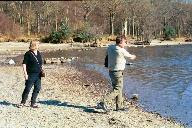Down to the store to buy a lightbulb. Only 75 and 100 watt ones available as well as various LEDs. Reminding us of the years before the advent of e-books when we used to stay in hotels that saved money by using lights with wattage too feeble to read by, limiting us to daytime reading. Until we began to take revenge by unscrewing their lightbulbs and replacing them with brighter.
As we leave we’re passed by a dog running delightedly past with a flip flop in his mouth. And remember that on our way down we had passed a slipper beside the sidewalk and wondered how someone could contrive to lose one bedroom slipper, canine theft not having occurred to us.
And on the theme of slippers, there is an article in today’s Cyprus Mail (Republic of Cyprus, South, Greek). A Cypriot theologian is protesting the prevalence of relics acquired for veneration in the country’s churches, saying it leads to fanaticism: “‘Venerating slippers and canes is idolatry,’ theologian Theodoros Kyriacou told the Cyprus Mail, referring to some of the items that have been displayed…In a famous case two years ago, the slippers of Saint Efraim were paraded around Cyprus, with long queues forming for almost three days at a church in Nicosia of the ‘faithful’ seeking to venerate the footwear.” Apparently the incentive for the churches is the fact that those venerating the relics are expected to make donations.
Archbishop Georgios agrees, saying that even as bishop of Paphos, he had never requested or attempted to bring remains of a saint, save for one time when he had requested through then Archbishop Chrysostomos II for the head of the Apostle Paul to be brought to Cyprus from Rome.
Archbishop Georgios added that the request had been granted, but the late archbishop had died just as permission had been given.”
In case we had thought the practice to be in the distant past.
As, coincidentally I am reading William Dalrymple’s From the Holy Mountain, in which he refers to the many venerated relics in seventh century Constantinople, including the nails from the crucifixion, the axe used by Noah in building the ark, and the head - including hair and beard - of John the Baptist. And this stirs another travel memory, although not one of Constantinople/Istanbul.
In Damascus we visited the Umayyad Mosque, I dutifully covered from head to toe. It was built on the site of the eighth century Church of John the Baptist and claims to hold the head of John the Baptist. an honour also claimed by churches in Rome and Amiens as well as a museum in Munich. And this not even a saint who claimed the gift of bilocation.
 |
| Courtesy of Middle East Eye |




